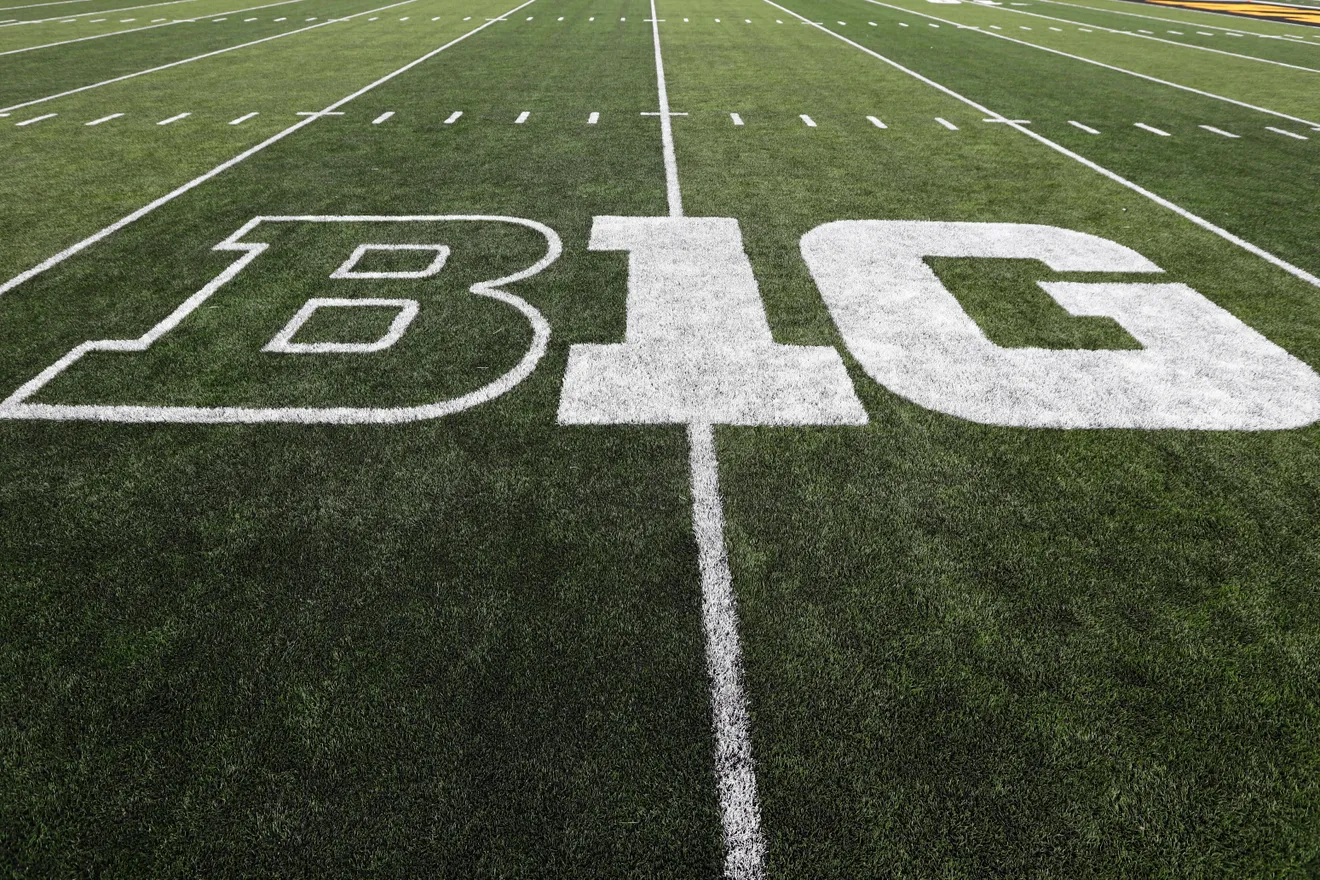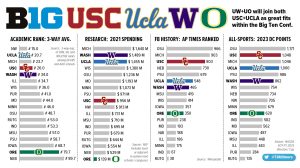
Mike Cagley, Co-Host IlliniGuys Sports Spectacular and Big Sports Radio
August 6, 2023
On Thursday, July 27, 2023, Colorado announced they were going to rejoin the Big 12 conference where they were a charter member. That was ten days ago - only ten short days ago. Since then, Arizona, Arizona State and Utah followed suit to join the Big 12 and Washington and Oregon have joined the Big Ten. All of this is effective next fall starting with the 2024 school year.
Some might call Deion Sanders arriving at Colorado as the catalyst for this seismic change. Deion would be okay with that assessment. A better catalyst would be the failure of the PAC-12 to land a television contract before the Big 12 "took all the available funds" which in turn opened the door to the chaos that we’re seeing right now.
And there’s a chance these seismic aftershocks might not be over.

Big Ten plus USC, UCLA, Washington and Oregon courtesy of Tony Altimore @TJAltimore.
Washington and Oregon are the two "sexy" choices when evaluating the PAC-12 teams that are looking for a long-term home, a conference with stability and a conference that can insure they will have the revenue and exposure that comes with an excellent broadcast deal.
Washington has been good over long stretches of time with its banner era being under head coach Don James who won a national title in 1991 and had 6 top ten finishes in his 18-year tenure. With the right coach, Washington is a proven winner on the national stage, and it would be the 5th best Big Ten school academically and 2nd best Big Ten school based on research spending. Seattle is the #14 television market as well. Bringing Washington into the Big Ten is a no-brainer, especially at a reduced half share (approximately $31 million annually to start the deal). When the PAC-12 could not produce a broadcast television deal, this left Washington and Oregon with a distinct lack of leverage in dealing with the Big Ten, especially if one considers the probable budget cuts for the academic department if television revenue was minimized.
While Oregon doesn't quite have Washington's staying power as a football program, Oregon has been good in football recently, with only 4 losing seasons since 1987. Since 2000, the program has 9 seasons ranked in the top 10, and 15 seasons ranked in the top 25.
When it comes to intangibles, Nike’s owner Phil Knight is an alum and Oregon pioneered the “cool” alternate jersey market and its gear is worn nationwide by kids as the brand has gone beyond being considered “cool”. It's now to the point where the Oregon brand almost defines "cool" for college gear in the eyes of the younger demographics of sports fans.
Academically, Oregon would be at the bottom of the Big Ten with only Nebraska ranked below Oregon. In the area of research, Oregon is way behind the entire Big Ten and could potentially benefit from joining the conference. It is important to point out that one should not blame Oregon and think it is a "bad" school. In this case, Oregon is a state flagship school and it's an AAU member. The simple fact is academically, the Big Ten conference is very good. It's also important to note that Oregon's spending on research is artificially low as their Portland-based medical school doesn't count towards these numbers because it was "spun off" in the 1960s to become the Oregon Health Sciences University.
In short, these two schools bring national credibility in football to the conference and while Oregon is no slouch academically, Washington is a heavy hitter. Critically, the quality of their football brands brings another good matchup to any network that is picking which games they will broadcast on a particular week.
If I were the Big Ten commissioner, the answer would be yes. In that role, I would also strive to bring them in at a price that is beneficial to the conference and its existing members. If I could bring them in at a number equal to or greater than the Apple deal but less than the half share that secured Washington and Oregon, that would be my goal.
What makes these schools attractive? Both Stanford and Cal reside in the #6 television market (San Francisco-Oakland-San Jose), and both are academic juggernauts. For quick comparison purposes, Stanford is probably the top academic school in all of the major sports and 4th overall in research. Cal would be similar to UCLA academically, but Cal’s research is around double anyone in the Big Ten depending upon how you calculate that number. These two teams make sense from a television and academic & research perspective.
Both teams have struggled recently in football. Stanford had a strong run under now Michigan coach Jim Harbaugh and coach David Shaw from 2009 to 2018, but the last four years have been bad with the team averaging 3.5 wins per season. When it comes to illustrious history, it’s hard to beat being able to say from 1924-32, Stanford was coached by the legendary Pop Warner.
Cal on the other hand, has not been able to put streaks of winning seasons together since Jeff Tedford led the team to 8 winning years in a row from 2002-2009. The team is currently on a 3-year streak of losing seasons. Cal is truly a sleeping giant when it comes to athletics. Will it ever wake is a fair question. Based on its location and prestige, it could - under the right coach.
Bringing on these two teams would really help with the logistics of having a six-team division/pod along the West Coast. It would allow for an easier transition as teams still have long-term, natural rivals in close physical proximity. Scheduling and travel would be much more manageable for the West Coast teams and teams traveling to visit them.
It also bears noting that someone must lose for another team to win. Even in a so called “super conference”, not every team can go undefeated. There is going to be a top tier in both academics and athletics. Cal and Stanford would rise and fall on the athletic side, but they would be competitive at the very top of the academic and research side of the ledger as much as Michigan and Ohio State would be at the top of athletic side.
Finally, with the PAC-12 falling apart, these two schools almost no leverage when it comes to negotiating for a "piece of the action" in terms of revenue shares. At even less than a half of the existing Big Ten-member share, this would suffice to allow these schools to continue to offer athletics as an additional way to develop students enrolling at their universities.
There is no “insider information” being offered here. However, there are plenty of tea leaves to be read when perusing through descriptions of television contract negotiations.
Let’s keep in mind a few assumptions:
Adding Washington and Oregon alone would allow for a good fourth game to be found to place on the schedule for whomever is broadcasting the “Big Ten After Dark” game. Stanford and Cal might offer a few matchups as well, but as they're in a down period, it might be a while before they're considered ratings winners.
The assumption would be that 1st pick goes to Fox for the 11 am game, 2nd pick to CBS for the 2:30 pm game, 3rd pick to NBC for the 7 pm game and (a new) 4th pick goes to whomever broadcasts the 10 pm game. Think of the matchups that haven’t been seen often. Let’s look at two “top shelf” teams from the Big Ten and what rare road games would be available:
Beginning in 2024, a typical Big Ten fan (or college football fan) could turn on his or her television at 11 am central to watch a game on Fox, flip over to CBS at 2:30 pm, watch NBC at 7 pm and then Fox Sports/ESPN at 10 pm. That’s about 14 hours of football – and we’re not even talking about overflow games on BTN and FS1. Even the NFL can’t keep their fans this engaged in their games. The Big Ten has created their own "B1G Saturday Ticket" that is like the NFL Sunday Ticket on steroids.
This is a column for another day. What makes this situation so incredibly fluid is if Florida State decides to leave the ACC, that nebulous day could be right around the metaphorical corner. To make the stakes even higher, if other teams in the ACC have had discussions with either the Big Ten or SEC (or both), it reportedly takes 8 teams voting to break the ACC contract. This would effectively make ACC schools free agents for next season as well. Buckle up. It might get bumpy. In this event:
It’s not hard to see the Big Ten moving to add Stanford and Cal and then picking up Notre Dame, Florida State, Miami along with North Carolina or Georgia Tech to make it to a 24-team league. Then 4 divisions of 6 team each are ready-made for football semifinals and a championship game - before moving on to a 12 or 16-team football tournament for the national title.
It’s too murky to accurately predict which teams will go where at this juncture. It’s also too early to predict when the ACC might split or if the ACC will come up with a plan to keep the conference alive despite its outdated television contract that runs through the 2036 season.
At the same time, I would assume the Big Ten office is putting together scenarios in case things move quickly. Don't mistake a quick Big Ten response for a Big Ten response that is not well thought out.
Things started to move quickly 10 days ago (or a lifetime ago if you’re the PAC-12). They could move like that in another 10 days.
Who knows what things will look like on August 16th.
Thanks out to Tony Altimore (find him on X at @TJAltimore) with some perspective on the ranking of academics, research and athletics of the Big Ten schools.